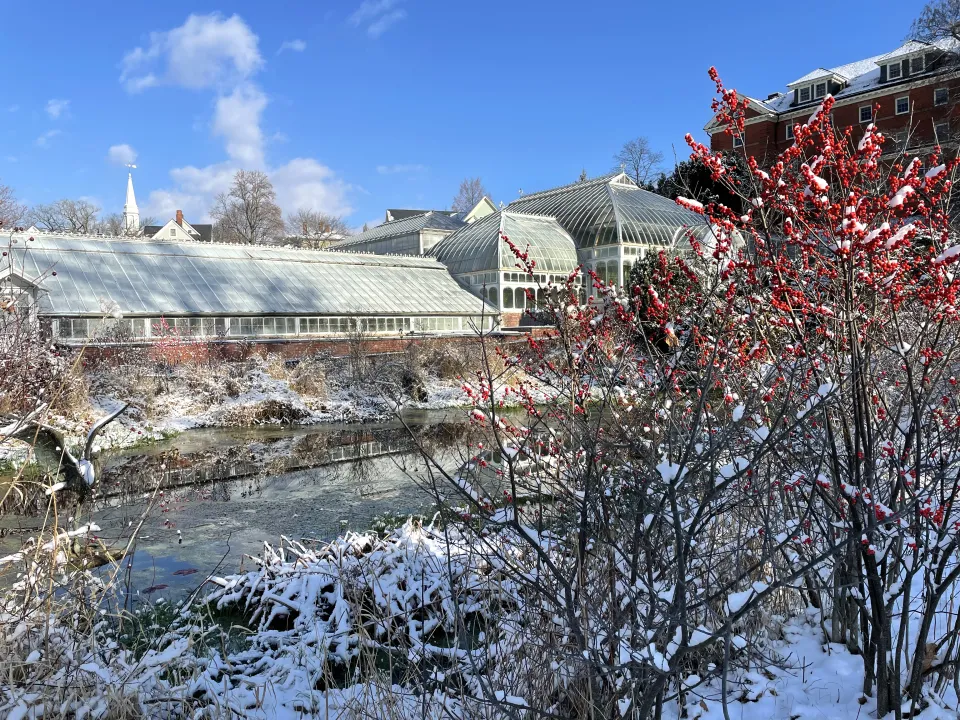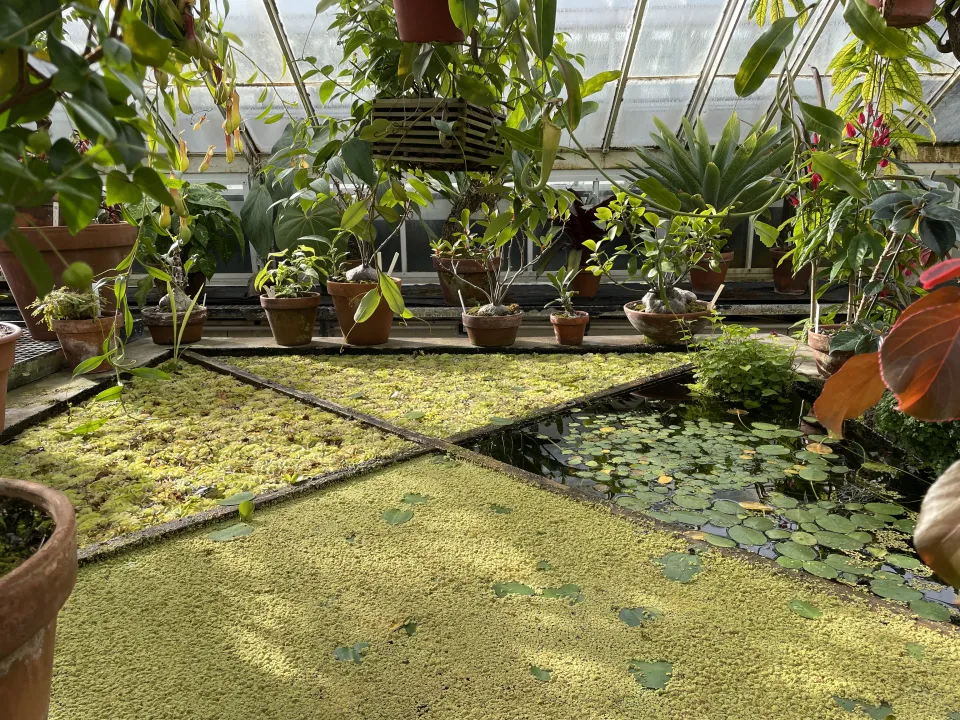A Year in Lyman Plant House
Botanic Garden - Leaflet
Leaflet 2022

Published March 25, 2024
For you, Lyman Plant House may be a place where things that you like live—things that are leafy, fragrant, flowery, or something else again. Maybe Lyman is a classroom for you, or a resting space, or a bathroom stop. Maybe the Lord & Burnham Victorian profile personifies for you—in a building sort of way—Smith College, or Northampton. Maybe it’s a part of the feeling you have for these places. For us, the team of horticulturists responsible for managing Lyman’s permanent plant collection, the greenhouse is a tool for creating environments that work for plants far from their natural homes in the world. It’s a big tool that operates like a clock through time as well as in space.
What do we mean, “like a clock”? Think of planet Earth as a series of annualized clocks stacked by latitude moving north and south from the equator. On the equator, every day of the year has 12 hours of daylight followed by 12 hours of night. But, as we all have experienced here in New England, the farther you move from the equator, the longer or shorter the daytime becomes, depending on whether you are in summer or winter. Wherever plants are from, they are acutely sensitive to day length and the seasonal changes in temperature and rainfall that accompany changing day lengths. Here in Northampton, our day is 9 hours and 5 minutes long on December 21 and 15 hours and 17 minutes long on June 21. While we can’t control day length in Lyman, we can anticipate changes in temperature and water requirements that plants expect based on their home clocks by sorting them among the different houses in Lyman and caring for them accordingly.

Winter Rhythms in Lyman
In winter, Lyman’s 12 houses are divided evenly between warm and cool environments, to suit plants from the ever-hot tropics as well as those from seasonally freezing Northern and Southern hemisphere temperate zones (and many places in between). Of the three of us, Dan manages plant culture on the warm side: the leafy tropicals in Palm, Fern, Stove, and Warm Temperate Houses. Lily manages the cool side: the winter- and spring-flowering camellias, citruses, orchids, and many other genera in Camellia Corridor, Physiology, Cold Storage, Cool Temperate, and Show Houses. And Jimmy manages arid-lands plants in Succulent House. But all three of us work in all of the houses to some degree, so we are in constant communication about plants in the spaces that we hold, especially when it comes to watering.
Our work would be easier if “tropical” meant “year-round warm and wet,” but the world doesn’t work this way. Almost all tropical forests across the planet experience rainfall seasonality, with periods of one to six months of little to no rainfall. To survive extended drought conditions, plants in these forests may drop their leaves and enter a dormant state similar to the deciduous flora of Southern New England in the winter. Their strategy is simple and sound: If there’s no water available, avoid stress by not using it! In Dan’s winter-warm houses, we have plants from aseasonal tropical regions that never want to dry out growing side by side with plants from seasonal forests that expect to be completely dry for months on end, and not necessarily all on the same schedule. We manage this by keeping track of where plants are from, and by responding to the cues they give us. Do we see fading, dropping leaves? Whether this indicates that a plant is entering dormancy or simply shedding old leaves in preparation for flushing new ones may depend on where in the world it is from and what the seasonal weather patterns are like there. When plants go dormant we switch them out of high light environments and move actively growing plants into their places. When possible, we move dormant plants out of the public greenhouses into our working spaces, which we refer to as Warm and Cool Genetics, until they wake up again. This helps us to not water them when they’re not expecting to be wet, and to keep a close eye out for when they emerge from dormancy.
The little-leaf mahogany tree in Fern House, Swietenia mahagoni, is a perfect example of this type of work. It experiences a strong dry season across its Caribbean natural range during our New England summertime, and wants to drop its leaves before flushing a new crown in June or July. Dan helps this cycle along by reducing water during late spring and early summer, and gradually watering more heavily when he sees the new crown growing in. His houses are full of specialty growing cases like this mahogany.
Lily’s winter-cool houses are filled with plants from northern and southern subtropical and temperate zones, where temperature seasonality grows stronger and stronger moving farther from the equator. Plants in these houses are constantly being moved throughout the year. The evergreen camellias from East Asia begin their growth period in spring, so we move them—the ones that are not too big to move, that is!—into high-light environments in Physiology and Cold Storage Houses as soon as the Spring Bulb Show ends in late March to encourage the vigorous growth they need in order to flower heavily through the following fall and winter. The intensely fragrant citruses flower and flush new leaves during this same period, and so they compete with the camellias for prime high-light growing spots. Most of our rhododendrons also flower and flush in spring, but they, along with the gardenias, prefer lower-light environments, allowing us to take advantage of the wide range of light environments in these houses. The spring-flowering orchids, especially Dendrobium kingianum and Dendrobium nobile, are from montane monsoon climates in Southeast Asia and Australia, meaning they naturally experience extended dry but cool periods after the monsoon rains end in late October. We stop watering them the first week of November and keep them behind the scenes in Cool Genetics House until they begin flowering in February and March.

Summertime in Lyman
As we move into summertime, many of the winter-growing and winter-flowering bulbs and corms from South Africa that feature in the Spring Bulb Show enter their dormant phase because their clocks are set to South African time. These we dry down and set aside until they wake up again in November or December. Meanwhile, the many varieties of Chrysanthemum that we grow for the Fall Chrysanthemum Show begin to grow vigorously after their winter dormancy. This means that prime south-facing growing space in Physiology and Cold Storage Houses must be cleared of camellias and citruses in early summer to make way for mums.
The annual comings and goings in Succulent House mainly concern three large groups of plants: the Cactaceae, the succulent Euphorbias, and the Aloes and their relatives in the family Asphodelaceae. The Cactaceae are, with a single exception, found only in the Americas, while most of the succulent Euphorbias, which may closely resemble the cacti in form and function but are a distinct evolutionary lineage, grow in Africa and South Asia. Both groups are large and diverse, but in general species from these two families have an active growth period that corresponds to our spring and summer following a winter dormancy. The cacti tend to wake up and enter dormancy a month or so earlier than the Euphorbias; we’ve also found, by hard experience, that the cacti prefer cool to cold winter temperatures during dormancy, while the Euphorbias must be kept warmer. During winter, we move about half of each group into storage in the Cool and Warm Genetics Houses, opening bench space in Succulent House for Aloes and their South African relatives, the Gasterias and Haworthias. These plants aren’t dormant during our winter but don’t mind the cool temperatures in Succulent House.
During our Northampton summer, all of the houses in Lyman run uniformly hot—too hot, really, for plants in pots, no matter where in the world they are from. The “greenhouse effect” is so-called for a reason: Daytime sunshine heats the greenhouse interior up, and that heat must rise and disperse at night in order for the groundlevel environment to cool. But Lyman, like all greenhouses of its vintage, is plagued by poor air circulation in and out of the glass building. The overhead and side vents, which stand fully open from June to September, aren’t able to vent enough hot air to adequately cool the houses overnight, and many plants suffer for lack of cool nighttime temperatures. Exacerbating this problem is the fact that nine of 12 Lyman houses are built in four abutting rows that are bookended by office and gallery spaces on their west ends and more greenhouse space—Palm and Cool Temperate Houses—on their east ends, further reducing the ability to vent hot air at night. We apply a special-formula white shade paint to the outside of Lyman in late spring to reflect sunlight away and reduce heat load indoors, but even so, Lyman greenhouses often top 100 degrees Fahrenheit in July and August. Because of this, we move as many plants as possible outside for the summer, especially cool-growing montane and full-sun species that need direct sun exposure. Again, the main benefit of growing outside during our summer is cool nighttime temperatures that reduce respirational load.
In the fall, plants staged outside for summer return indoors, and the shade paint is scrubbed off the Lyman roofs to maximize the pitiful amount of sunshine New England receives by mid-December. The mums that we’ve grown (and pinched) all summer now fill up two houses, Physiology and Cold Storage, and the Fall Chrysanthemum Show, designed by Dan, takes shape. Spring Bulb Show bulbs are potted up by Smith students in late October, stored wet in our bulb cooler at about 38 degrees Fahrenheit until early January, and then brought out to fill all the spaces recently vacated by the mums. Lily puts the show together in February, with help from staff and work-study students who also keep Lyman spaces and plants clean, tidy, and groomed.
Lyman communities change constantly through the seasons in response to our Southern New England latitudinal clock and to the geographic-based internal clocks that the plants in our different spaces run on. We think of this as analogous to how nothing stays the same from one day to the next in natural communities, in subtle and dramatic ways. For us, and hopefully for visitors and learners, every day in Lyman brings its own unique experience of plants in place and time.